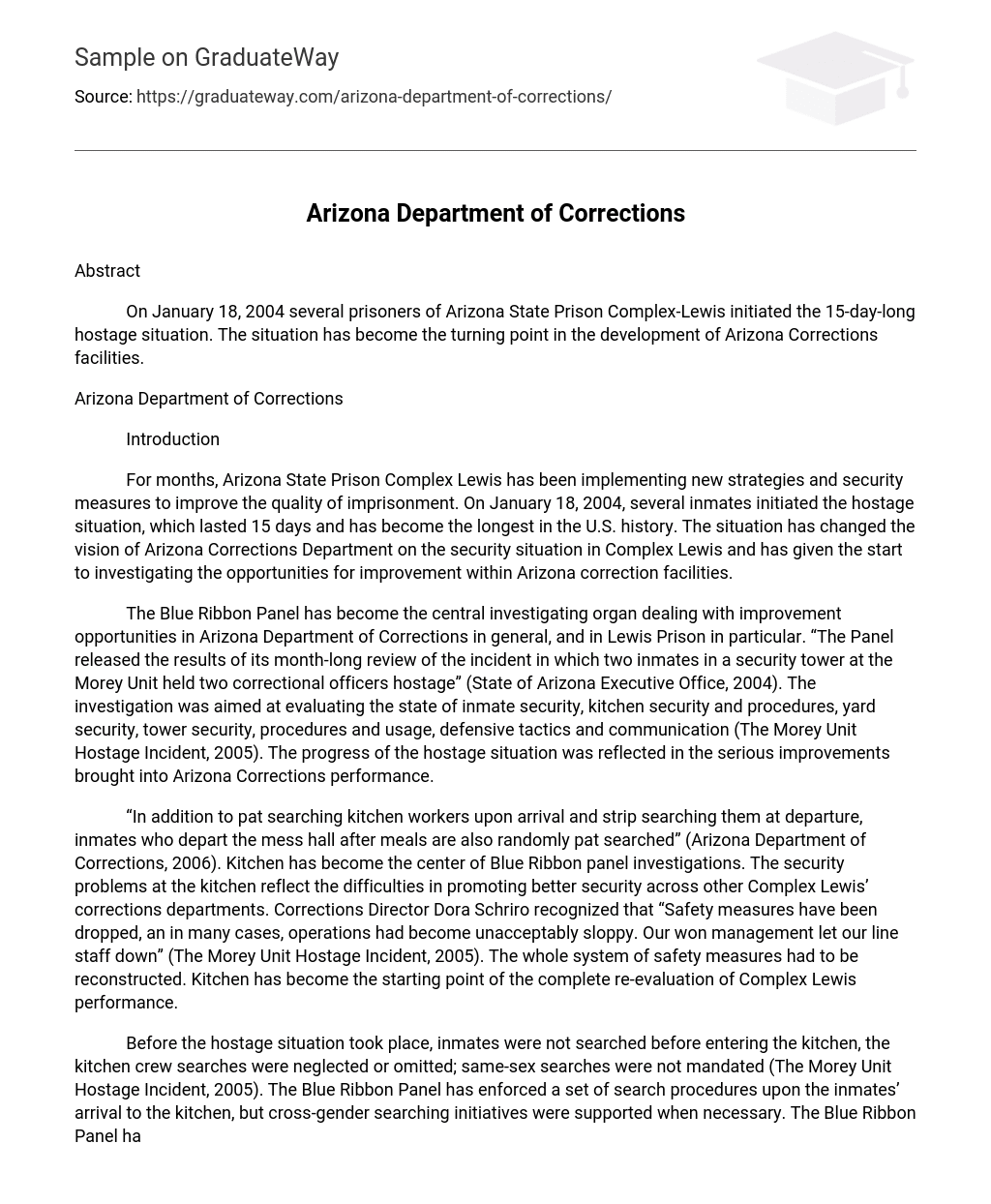Abstract
On January 18, 2004 several prisoners of Arizona State Prison Complex-Lewis initiated the 15-day-long hostage situation. The situation has become the turning point in the development of Arizona Corrections facilities.
Arizona Department of Corrections
Introduction
For months, Arizona State Prison Complex Lewis has been implementing new strategies and security measures to improve the quality of imprisonment. On January 18, 2004, several inmates initiated the hostage situation, which lasted 15 days and has become the longest in the U.S. history. The situation has changed the vision of Arizona Corrections Department on the security situation in Complex Lewis and has given the start to investigating the opportunities for improvement within Arizona correction facilities.
The Blue Ribbon Panel has become the central investigating organ dealing with improvement opportunities in Arizona Department of Corrections in general, and in Lewis Prison in particular. “The Panel released the results of its month-long review of the incident in which two inmates in a security tower at the Morey Unit held two correctional officers hostage” (State of Arizona Executive Office, 2004). The investigation was aimed at evaluating the state of inmate security, kitchen security and procedures, yard security, tower security, procedures and usage, defensive tactics and communication (The Morey Unit Hostage Incident, 2005). The progress of the hostage situation was reflected in the serious improvements brought into Arizona Corrections performance.
“In addition to pat searching kitchen workers upon arrival and strip searching them at departure, inmates who depart the mess hall after meals are also randomly pat searched” (Arizona Department of Corrections, 2006). Kitchen has become the center of Blue Ribbon panel investigations. The security problems at the kitchen reflect the difficulties in promoting better security across other Complex Lewis’ corrections departments. Corrections Director Dora Schriro recognized that “Safety measures have been dropped, an in many cases, operations had become unacceptably sloppy. Our won management let our line staff down” (The Morey Unit Hostage Incident, 2005). The whole system of safety measures had to be reconstructed. Kitchen has become the starting point of the complete re-evaluation of Complex Lewis performance.
Before the hostage situation took place, inmates were not searched before entering the kitchen, the kitchen crew searches were neglected or omitted; same-sex searches were not mandated (The Morey Unit Hostage Incident, 2005). The Blue Ribbon Panel has enforced a set of search procedures upon the inmates’ arrival to the kitchen, but cross-gender searching initiatives were supported when necessary. The Blue Ribbon Panel has supported the idea of establishing a Special Contraband Squad to conduct “random unannounced searches of prison units” (Arizona Department of Corrections, 2006). The unannounced searches are critically important for the prevention of violent conflicts between the security guards and the inmates. The new corrections strategy requires quarterly search of all incoming vehicles, implementing Complex Lewis traffic control, and redirecting the inmate traffic away from administration’s building (Arizona Department of Corrections, 2006).
The security of towers is a separate topic of Blue Ribbon Panel’s discussion. The hostage situation took place in the tower, and towers require special attention. The Panel has found excessive points of access for inmates, and has confirmed the absence of identification confirmation protocols. The tower was subject to non-permitted uses: using the tower for storage of medicines provided the inmates with a free access to tower facilities and with an opportunity to gather information about the tower. “The revised post order prohibits inmate access and restricts staff access to towers. Access by any person other than shift-assigned tower staff, tower relief staff and shift supervisors requires the shift commander’s pre-approval” (Arizona Department of Corrections, 2006). In terms of communications strategies, Arizona Department of Corrections is required to fully grasp the full advantage of technology to promote improved monitoring techniques throughout the facility.
Conclusion
The hostage situation has become the reason for continuous security investigation and research in Arizona Department of Corrections. The Blue Ribbon Panel has identified significant gaps in security measures, monitoring techniques, and tower access. The progress of the hostage situation is reflected in the significantly improved performance of Arizona Corrections facilities.
References
Arizona Department of Corrections. (2006). Blue Ribbon Panel recommendations. Retrieved
18 April 2008 from http://www.adc.state.az.us/News/2005/blue-ribbon.html
State of Arizona Executive Office. (2004). Blur Ribbon Panel hears testimony: Improvements
at Lewis Prison. Retrieved 18 April 2008 from http://www.governor.state.az.us/press/2004/0404/04_04_21.pdf
The Morey Unit Hostage Incident. (2005). Retrieved 18 April 2008 from
http://web.archive.org/web/20040725030710/http://www.governor.state.az.us/press/0403/finalreport.pdf





